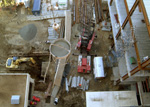Construction site dangers offer choice of convenience
by Dick PetersonPublic Relations
A prematurely shortened life. Career plans crushed under a ton of steel. Research projects left inconclusive and unpublished.
Those are inconveniences.
 A
load of fresh concrete hovers over a covered walkway leading across the
Children's Research Institute construction site toward G-lot and Bee Street.
Pedestrians leaving the back door of the Basic Science Building have been
using the walkway intended only for construction workers, placing themselves
in danger of serious injury.
A
load of fresh concrete hovers over a covered walkway leading across the
Children's Research Institute construction site toward G-lot and Bee Street.
Pedestrians leaving the back door of the Basic Science Building have been
using the walkway intended only for construction workers, placing themselves
in danger of serious injury.
Having to walk out the front door of the Basic Science Building, down a shaded brick walk around the Macaulay Dental Museum and between Colcock Hall and St. Luke’s Chapel to G-lot to avoid those inconveniences is not.
“We’ve seen people walk out the back door of Basic Science under steel girders suspended from a crane,” said research operations administrator Leslie Kendall. She and university engineer Mac McClinton expressed concern Monday for the safety of individuals who persist in cutting through the Children’s Research Institute construction area to avoid the “inconvenience” of a safer route.
As the institute construction progresses, three cranes hoist the steel girders that give skeletal support to the building while concrete is pumped overhead to form the floors. Below, trucks and earthmoving equipment move in and out of the area while deliveries to the Basic Science Building loading dock continue. Biological waste disposal adds still another level of activity in an already crowded and increasingly hazardous area.
Kendall and McClinton acknowledge that while risk always accompanies a construction project and those working on the construction accept that risk as part of the job, people who are not needed in the area should stay away. Despite fencing that has nearly surrounded the area, necessary access openings remain, and people use them.
“The liability is tremendous,” McClinton said. “This whole safety issue has made us nervous.” He explained that construction personnel watch out for each other, but aren’t prepared for the lone pedestrian on the way to his car.
More fencing will further close in the area and a security guard will be posted to ensure that only those working in the area are on site, McClinton said.
Despite all the precautions, fencing, signs, security and warnings, safety is an individual choice. Either step through dirt and mud under swinging steel I-beams and full concrete hoppers, or walk a brick path that wends through landscaped gardens and under the shelter of stately oaks.
It’s a choice between a dangerous inconvenience or a convenient interlude
in an otherwise hectic day, Kendall said.
Catalyst Online is published weekly, updated as
needed and improved from time to time by the MUSC Office of Public Relations
for the faculty, employees and students of the Medical University of South
Carolina. Catalyst Online editor, Kim Draughn, can be reached at 792-4107
or by email, catalyst@musc.edu. Editorial copy can be submitted to Catalyst
Online and to The Catalyst in print by fax, 792-6723, or by email to petersnd@musc.edu
or catalyst@musc.edu. To place an ad in The Catalyst hardcopy, call Community
Press at 849-1778.